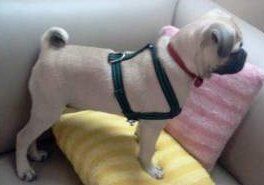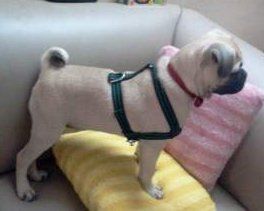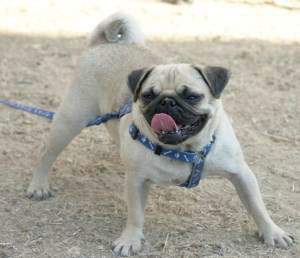Choosing the Best Harness and Collar for a Pug
Already know why a harness is the better option and just want to see recommendations?
Jump to: Choosing a Harness
Overview
Milo (at 1 and 1/2 years old) and Tilly (at 2 years old), photo courtesy of The Wilknson-Scott
The collar and harness that a Pug wears plays a vital role in the health and well-being of this breed. Owners who wonder if a collar or a harness is better for a Pug dog, the answer is that both are important accessories for this breed and each will serve different purposes.
Please note:
PetPugDog is reader-supported, and some of the product suggestions on this page may be affiliate links. As an Amazon Associate we earn from qualifying purchases. This is at no extra cost to you and helps keep this site running.
What can Happen When on Leash & Collar
For the majority of dog breeds, the collar serves as the apparatus to attach the leash. However, for the Pug this is should not be the case since this is a brachycephalic breed.
Being brachycephalic, the face is flat with a short snout. Nasal and airways passages are compressed, with many Pugs having some level of stenotic nares (narrows nasal openings). The soft palate located in the back of the throat is often elongated, causing some issues with breathing.
Due to the structure of the face and the short neck of the Pug, ability to breath correctly is already an issue with this breed. If the leash is connected to the collar all pressure, force and tension is placed directly onto a Pug's neck.
This can cause several serious issues including:
- Compression and constriction whenever the Pug pulls ahead and the leash goes taut, causing increased breathing difficulties
- Injury to the windpipe if the Pug lunges to the side or jerks his head including the very serious issue of collapsed trachea in which rings of cartilage surrounding the windpipe collapse inward.
- Increased risk of disc disease and neurological problems
For these reasons, the collar should hold the Pug's ID tags and in areas that require it by law, proof of rabies vaccination and/or registration information (more ahead on how to choose the best collar).
The Harness
A proper harness should be the apparatus that is used any time that a Pug dog is on leash. As opposed to a collar, the harness will distribute pressure, force and tension across the dog's shoulders, chest and back.
These areas of the body are much sturdier since they are comprised of bone and muscle as opposed to softer cartilage and ligaments of the neck. Using a harness frees the Pug's neck from potential injury and allows the Pug puppy or dog to breathe easier when on leash.
In addition, the right harness will give an owner better control when walking a Pug. This is a curious breed that often tends to want to lead while on walks. A harness allows an owner to better control the puppy
or dog, keeping him on course, without having to worry about causing any type of neck injury or pulling that would inhibit breathing in a dog that already has struggles in this respect.
Choosing a Collar for Your Pug
Though connecting a leash to a collar is not recommended, you may still want your Pug to wear one for other reasons. This would including to hang a dog tag for ID purposes. And many owners find it easier to have a collar on their dog inside the home to help facilitate handling such as grooming.
There are over 20 different types of collars and there are only a couple that are ideal for this breed. Let's first look at what type of collar should NEVER
be used:
X
Flat Buckle Collars -
These are similar to a belt in which the sizing of the collar's diameter is adjusted with prongs that slip into punched holes. The issue with these is that you need to fidget with the buckle when taking it off and with this breed, breathing issues can come on very quickly. You'll want a collar that you can take off almost instantly.
X
Choke collar -
These are exceedingly dangerous for the Pug breed. Made of chain with rings at the ends; both 'dead' and 'live'. When a leash is attached to the live ring, the chain instantly slips tighter when the dog pulls, causing a massive jerk to the neck.
X
Prong collar -
These are used as a means of control via pinching the dog's neck when he pulls while on leash. The interlocking steel link collar's metal spikes are considered - by many- to be inhumane for any dog.
The choke and prong collars mentioned above have been associated with whiplash, spinal cord injuries leading to paralysis, fainting, collapsed trachea, asphyxiation, fracture of the bones in the larynx, bruising of the esophagus, dislocated neck bones, damage to the skin
and tissues in the neck, brain damage and dislocated eyes
(the eye(s) are forced from the socket due to excessive restraint to the head and neck).
Now, let's look at the best collars for a Pug puppy or older dog. For this breed, the two best options are:
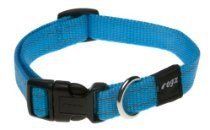
Flat collar, quick release -
This consists of one flat, adjustable strap that fits around the neck. It closes with a clasp that is ideal for fast removal. You'll want it to be lightweight yet sturdy, weather resistant and with stitching only on one side to prevent irritation.
Our favorite choice:
Flat collar, break away -
Similar to the quick release collar, this is a flat, adjustable collar in which the clasping mechanism will break apart if excessive force is placed upon it in emergency situations. Examples would be if the Pug's collar got accidentally caught on an object such as fencing, a part of a safety gate or even a chair, in which the dog would otherwise be strangled.
Our favorite choice:
Weight and Sizing
Now that we have it narrowed down to only a flat collar with either a quick release or breakaway clasp, you'll want to choose one that correctly fits your Pug in regard to both weight and diameter.
Material -
The material that the collar is made of along with its thickness will determine how heavy it is and therefore how much weight will be placed on a Pug's neck. Flat collars (the type recommended for this breed) can be found in an array of materials that include leather, polyester or nylon webbing. Let's look at the choices:
Polyester -
This is a cheap material that is made from synthetic polymers. This low quality fabric wears out extremely quickly, absorb and hold body oils that can lead to terrible smells and are not a good choice.
Leather -
These collars can look very stylish though the downsides are that these are not waterproof and some cheaper leathers can stretch out over time.
Nylon -
Webbed nylon, flat collars with a quick release or breakaway clasp are the best choice for most Pugs. A quality collar made of nylon webbing will be weather resistant, washable, resistant to odors and sturdy.
Size -
The general rule of safety and comfort is that once the collar is on, you can easily slip two fingers between it and your dog's neck. This allows it to be loose enough to avoid any type of constriction but be tight enough that it cannot slip off or be easily snagged onto something. While the collar for your Pug will be adjustable, you'll want to make sure that as your puppy grows, it can be sized to still fit those two fingers underneath.
Pug puppies often wear collars sized for toy breeds, though this will change after the first year. Since the Pug is the largest of all toy breeds with an adult weight of 13 to 18 pounds (5.89 to 8.16 kg), though many adults are 20+ pounds (9.07+ kg) and a relatively thick neck, the adult Pug often needs a collar sized for small and medium breeds as opposed to toy breeds.
How Many Collars You Should Have for Your Pug
You'll want to have at least 2 quality collars so that if one is taken off your Pug and misplaced, you'll still have one on hand. The collars should be periodically checked for any wear and tear. Depending on their use (if you always use one and the backup one is rarely used) you may need to replace the collar anywhere from every 2 to 5 years.
Times to Remove the Collar
Many owners wonder if it is okay to keep the collar of a Pug when the dog is at home inside the house. One element that you'll want to be exceedingly aware of is the chance of the door being opened and the Pug darting outside.
If you do take the collar off when at home, it can help to have a rule that even household members knock on the door to announce their presence so that the dog can be held while the door opens.
While it can be freeing for a dog to be collar-free while sleeping and playing inside of the house, for some this can cause intolerance for times that it must be placed on.
Bittoo, 20 months old
Photo courtesy of Vishnoo Sangeet Dubey
For puppies in the house training phase, it's best to keep it on at all times since you may only have seconds to bring the pup to the designated bathroom area and spending time putting the collar on can result in an accident inside the home.
It is recommended to take a Pug's collar off when brushing the coat. Since this is a heavy shedding breed, the collar can impede proper grooming. You'll want to be able to do long strokes down the back of the head, over the neck and along the back in addition to the front of the neck and down the chest.
It should also be removed during baths to properly scrub and rinse the coat; keeping in mind that a wet dog is quite slippery and all exit points of the house should be secured to prevent an unplanned escape.
For Pugs that have breathing problems due to tracheal collapse or other medical issues, the veterinarian may recommended that the collar be kept off while the dog recovers.
Choosing a Harness for Your Pug
As mentioned above, a harness is a necessary accessory to use any time that a Pug is on leash. Using a collar for this purpose can often lead to breathing problems, injury and/or health conditions.
Some owners shy away from harnesses due to a bad experience of the Pug resisting or showing intolerance for it; however in most cases this is just a matter of the dog needing time to become accustomed to it and having one that is comfortable.
The best type of harness for a Pug will be easy to slip on and will fit comfortable without pinching the skin. Let's look at some things to keep in mind:
1)
A comfort wrapped, strapped harness is the best choice for most Pugs as these are designed for flat faced breeds with wide chests. The width of the straps should be 1/2 inch for puppies and 3/4 to 1 inch for adult Pugs, depending on his/her overall size and weight. If the straps are too thin, they will pinch and cut into the dog's skin, causing discomfort, redness and even sores.
2)
While harnesses can be found in leather, the best material will be nylon as it is sturdy, resistant to odor, weather resistant and lightweight.
3)
It's hard to get a Pug to step into a harness and trying to do so can cause the dog to become frustrated. One of the best harnesses for Pug dogs is one that has easy 'quick-snap' buckles on the shoulder and/or belly. This way, it's super easy to put on and off within seconds.
4)
Stretch mesh harnesses can work well for puppies; they slip on similar to a shirt. However, adult Pugs are more powerful and this type of harness often does not properly distribute pressure on a dog as large as a full grown Pug.
5)
While wearing a quality harness will not have any adverse effects to the coat during short term use, it should be removed when the leash is taken off. Leaving it on can cause body oils to accumulate under the strapping, blocking healthy air circulation to both skin and coat.
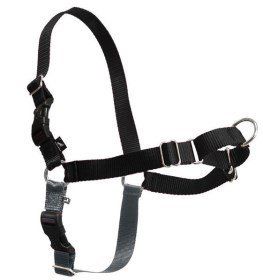
Our favorite choice:
It has these great features:
- Quality nylon that is sturdy but
soft to the touch (won't chafe a Pug's skin)
- Has quick-snap buckles on both
the shoulder and belly (making it super easy to put on)
- Has a Martingale loop on the chest piece (this prevent the harness from twisting)
- The strap that goes under the Pug is a slightly different color, so you'll always know how to put it on
Did you find this article helpful?
If so, you'll love The GIANT Book of Pug Care
(available in both hard copy & eBook)


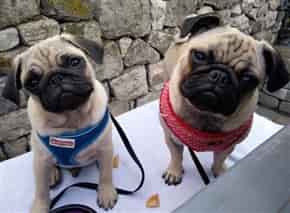
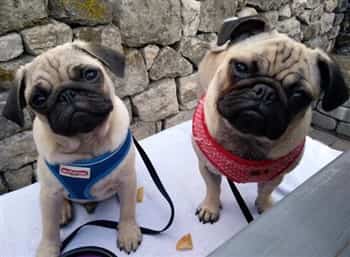
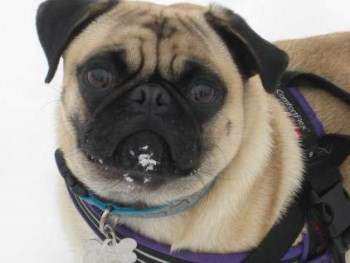
-250x202.dm.edit_90Yo94-1920w.jpg)
